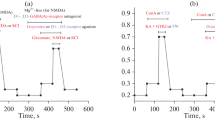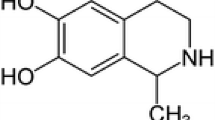Summary.
Dopamine agonists play an important role in the treatment of Parkinson's disease by reducing the administration of L-3,4-dihydroxyphenylalanine (L-DOPA). The enzymatic and non-enzymatic conversion of L-DOPA is suspected to increase oxidative stress, which leads to the degeneration of dopaminergic neurons in Parkinson's disease. In primary mouse mesencephalic cultures we show that the dopamine D1/D2 receptor agonist lisuride, in a concentration range of 0.001–1 μM, enhances the survival of dopaminergic neurons, protects against toxicity induced by L-DOPA or 1-methyl-4-phenylpyridinium ion (MPP+) and stimulates 3H-dopamine up-take. Lisuride also reduces anaerobic metabolism during incubation with L-DOPA. The present findings suggest that lisuride may have trophic/survival-promoting properties and potentially reduces oxidative stress.
Similar content being viewed by others
Author information
Authors and Affiliations
Additional information
Received September 27, 2001; accepted October 23, 2001
Rights and permissions
About this article
Cite this article
Gille, G., Rausch, WD., Hung, ST. et al. Protection of dopaminergic neurons in primary culture by lisuride. J Neural Transm 109, 157–169 (2002). https://doi.org/10.1007/s007020200011
Issue Date:
DOI: https://doi.org/10.1007/s007020200011




